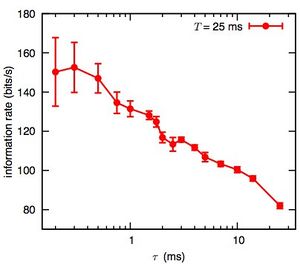Information processing in biological systems
Return to Home or Overview of Professional Activities.
Return to Research Projects list.
Last updated on 29 February 2012.
What is this about?
One of the universal functions performed at all levels of biological organization is information processing and shaping of the response. This is known under various names, such as signaling, signal transduction, learning, adaptation, and so on. In different systems, it is important to understand: What are the limits to biological information processing? Which features of the response carry information about the signal, and vice versa? and Which structural features of the system control its information-processing abilities? These questions are naturally asked in the language of information theory.
Working with different experimental groups, we have asked these questions in a variety of biological systems. In some we got answers, and we are still working on the others. For example, to the left, one can see the plot of the amount of information transmitted by the fly visual motion sensitive neuron that as a function of the accuracy of the spike timing resolution. Clearly, positioning of a spike down to a few hundreds of microseconds is important.
Results
Fly
We have analyzed information transmission in the fly motion sensitive neuron, Nemenman et al., 2008 and found that
- Information is carried by spike positioning down to a few hundreds of microseconds resolution.
- Even though the signal changes on a scale of about 60 ms, the fly finds something new to say about it every 25 ms or so.
- Even at bright daylight, when the fly gets over photons per photoreceptor per second, the animal still cares about square root counting error in the photon number.
NF-kB
We have measured information transmission through the NF-kB stress-response circuit in mouse fibroblasts, activated by the TNF signal, Cheong et al., 2011. We observed that
- The system's channel capacity is a surprisingly low value of <1 bit/signaling event.
- The reason for this is the information loss at the TNF receptor.
- Of all ways to mitigate the information loss, only one, collective decision making among the cells, can do the trick.
Theoretical Studies
We have been able to derive limits imposed by molecular and statistical structure of the surrounding world and the molecular circuitry employed by organisms on their ability to transmit information, see Ziv et al., 2007.
Future work
In collaborations with many great experimental groups, we are now applying the same methods to analyze signaling in amoeba, worm, bacteria, and yeast. Very importantly, as experiments move from measuring intracellular signals to measuring responses of whole organisms (unicellular or multicellular) to changes surrounding environments, research projects from this block will naturally merge with studies of animal adaptive behaviors. There are more exciting open questions than I can even hope to enumerate here. Get in touch with me if you want to work on these together.

